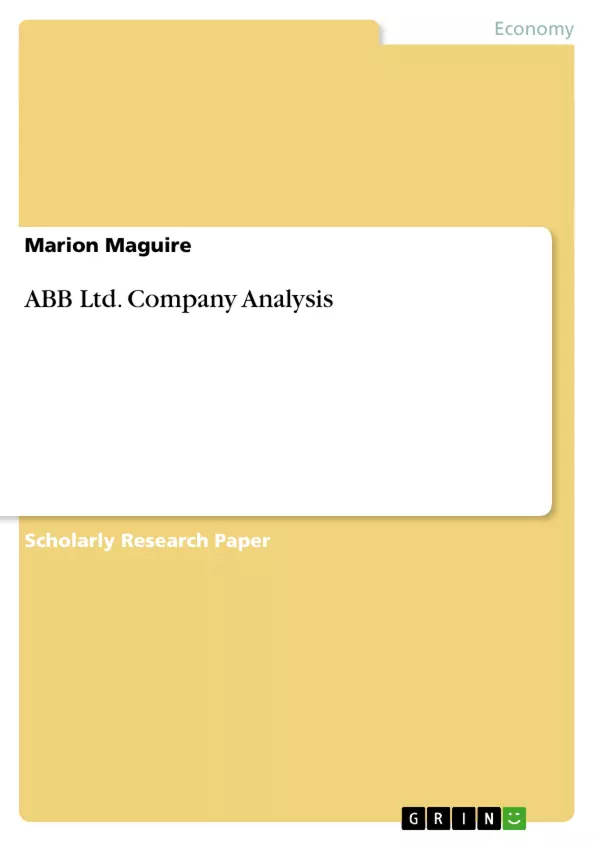ABB Ltd. is a leader in power and automation technologies. ABB provides products and systems for industrial, commercial customers, and financial services using the most advanced technologies and applications. The ABB Group was formed in 1987 through the merger of the Swedish company Asea with the Swiss company Brown Bovery. Presently its core company is organized into 5 divisions and the following are the percentages of the 2002 gross revenues:
- Automation Technology (22%)
- Utilities (21%)
- Industries (19%)
- Power Technology (19%)
- Other (19%)
Percy Barnevik, who at that time was the CEO of Asea, became the CEO of this new established corporation. Back in 1996, the National Electrical Manufacturers Association (NEMA) recognized Barnevik as an “innovative inspirational leadership in the electro industry and his role as a chief architect of a global company that recognizes no national borders and vigilantly protects the spirit of entrepreneurship” (ABB, 1996). Through his new management style and through delegating responsibilities to its managers, ABB became a predominant player in the Industrial electrical equipment industry competing with companies such us: Emerson Electric, GE, ITT Industries and Nidec Co. with operation in around 100 countries and employing about 115,000 people.
Inhaltsverzeichnis (Table of Contents)
- Introduction
- Transnational Framework
- Global Localization
- Value Chain Analysis
- Other ways of looking at EPG
- Strategies
- The Organizational Structure
- SWOT Analysis
- SWOT Turnaround Framework
- Risk Analysis/PEST Model
- ABB's current situation
- Is ABB's worldwide reputation justified?
Zielsetzung und Themenschwerpunkte (Objectives and Key Themes)
This case study analyzes ABB's success in building and managing a global matrix organization. The objective is to examine the key elements of ABB's transnational framework, global localization strategy, and organizational structure, and assess how these factors contributed to ABB's rise as a global leader in the industrial electrical equipment industry.
- Transnational Framework: Exploring ABB's strategic approach to balancing global integration and local responsiveness.
- Global Localization: Analyzing how ABB adapted its operations to diverse markets while maintaining a global vision.
- Organizational Structure: Examining the matrix structure implemented by ABB and its impact on decision-making, communication, and efficiency.
- Strategic Management: Evaluating the role of leadership, delegation, and innovation in ABB's success story.
- SWOT Analysis: Identifying ABB's strengths, weaknesses, opportunities, and threats in the global market.
Zusammenfassung der Kapitel (Chapter Summaries)
- Introduction: This chapter provides an overview of ABB Ltd., its history, core divisions, and key leadership figures. It emphasizes the company's focus on power and automation technologies and its global reach.
- Transnational Framework: This chapter delves into the strategic framework that guided ABB's global expansion. It explores the concept of transnational companies, highlighting their commitment to global efficiency and local responsiveness. The chapter emphasizes ABB's ability to achieve both through a matrix structure and a decentralized decision-making process.
- Global Localization: This chapter examines ABB's strategy for adapting to diverse markets while maintaining a global brand. It discusses how ABB's leadership empowered local managers to adapt operations to specific market needs, fostering both global integration and national responsiveness.
- Value Chain Analysis: This chapter analyzes the different stages of ABB's value chain, exploring how each stage contributes to the company's overall success. It examines the key elements of ABB's value chain, such as research and development, manufacturing, marketing, and customer service.
- Other ways of looking at EPG: This chapter provides alternative perspectives on ABB's strategic choices, exploring different frameworks and approaches to analyzing the company's performance.
- Strategies: This chapter focuses on ABB's core strategies for achieving growth and competitive advantage in the global marketplace. It examines the various strategies employed by ABB, such as product differentiation, cost leadership, and strategic alliances.
- The Organizational Structure: This chapter examines the matrix structure implemented by ABB, its advantages and challenges, and its impact on communication, decision-making, and efficiency.
- SWOT Analysis: This chapter analyzes ABB's strengths, weaknesses, opportunities, and threats, providing a comprehensive overview of the company's competitive landscape.
- SWOT Turnaround Framework: This chapter delves into the SWOT Turnaround Framework, exploring how ABB can leverage its strengths and opportunities to address weaknesses and threats.
- Risk Analysis/PEST Model: This chapter analyzes the risks facing ABB, employing the PEST Model to assess the impact of political, economic, social, and technological factors on the company's operations.
- ABB's current situation: This chapter provides an overview of ABB's current position in the market, assessing its performance, challenges, and potential for future growth.
Schlüsselwörter (Keywords)
This case study examines the key concepts of transnational framework, global localization, matrix structure, strategic management, SWOT analysis, and risk analysis as they relate to ABB's success story. It explores the company's growth from its merger in 1987 to its position as a global leader in power and automation technologies.
- Quote paper
- Marion Maguire (Author), 2004, ABB Ltd. Company Analysis, Munich, GRIN Verlag, https://www.grin.com/document/35475



